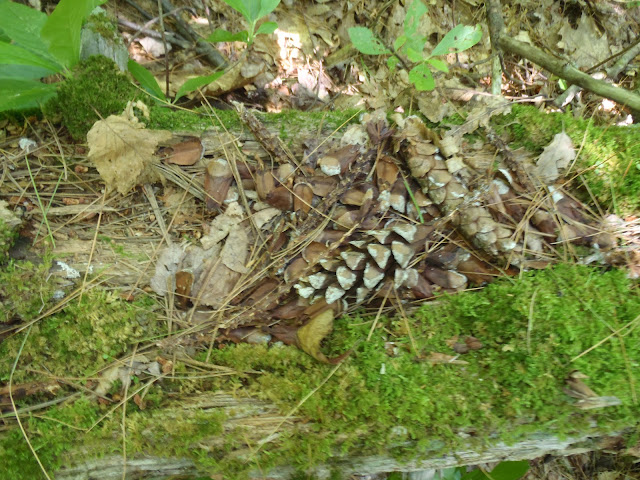Day three of the Summer Institute was probably the best so far. We met at the BHW with Dan Gardoqui, the founder and director of White Pine Programs
www.whitepineprograms.org. It's no wonder he runs many successful youth and adult programs as he is both engaging and knowledgeable. The very first thing he had us do was something that is pretty much against anything I've ever been taught hiking and camping...go off trail. We set off east into the woods bushwacking our way through the landscape, climbing over fallen logs and tromping through (luckily mostly dry) wetlands. On the way we found some very exciting things.
 |
| Midden Pile: Pile of left over materials from an animal eating. Note the pieces of pine cone left over and in the lower left hand the stem of what was the inside of a pine cone. |
 |
| This is a tupelo black gum tree with a large pile of porcupine scat at the base. |
 |
| This image shows the porcupine claw marks as it climbs to the top of the tree to feed on the thinner bark up high. For the record, its a myth that porcupines can shoot their quills. |
 |
This scat pile at the base of a white pine tree is from a flying squirrel. First, carpenter ants colonize the tree (did you know they are edible?), then the pileated woodpecker pecks holes into the tree to get at the carpenter ants. After, the hole provides a perfect habitat for a squirrel.
|
 |
| Bark scraped off by a deer that was incisor feeding. |
 |
| These holes drilled by the yellow bellied sap sucker form a ring that circles the trunk. The work of the sap sucker is also beneficial to hummingbirds during their migration since nectar is often scarce at that time. |
 |
| and finally some more scat...because who doesn't like looking at poop? This is from a raccoon (located at the base of a large tree near a wetland) |
After our hike we returned to campus where I gave a presentation to the class. For homework we had read two articles dealing with how environmental education is left out of most children's schooling. It was my job to come up with activities and discussions to reinforce the material and teach it as if it was a 45 minute class. First, I led an activity where students sat outside with a ring of string placed on the grass and they recorded what they saw on the grass over a 5 minute period. We then discussed how this activity could be used across many different curriculums. I thought the discussion went well and I got good suggestions for the future such as being sure to designate boundaries for where students can go and also to be sure not to restrict students choice of where they could place their circle.
After, I had the students work on posters that got them to think deeper about statements that were made in the article. Though I felt like I stumbled over the right wording for some of my questions, the students had a good discussion. I finished by having the students work on a writing prompt that brought together some of the themes. Overall, I thought it went well and it felt good to be up in front of a class again.
We wrapped up the day with some review of Carbon and it's impact on the earth. It was surprising to see the range of background knowledge that people come in with. It was a good refresher.
Tomorrow we will be meeting with Randy Warren, a property owner and farmer near the the BHW. He is going to share some of the history of the land. From the bits and pieces we have gathered so far (the area was used for logging for some time and the old homestead), I think tomorrow should be really interesting.







Your reading facilitation was a success. I appreciate you volunteering for the first opportunity. You incorporated many elements that helped to model effective teaching (e.g., 'do now' activity, exit ticket).
ReplyDelete